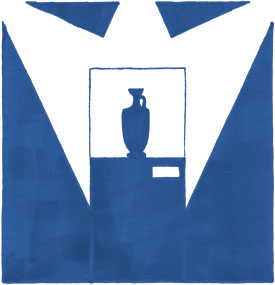CHAPTER11ENCOUNTER
A cool marble doorway separates me from a velvety black space. I step in. Walking forward, I look up and notice I cannot see the ceiling, there is just inky black. As my eyes adjust to the darkness, a dozen halos of light sharpen. Approaching the nearest one, I see it is an exquisitely lit glass box with a small clay vase inside. It is decorated with iconic geometry in madder red, burnt orange, and black. Not much bigger than my hand, the vase is at the perfect height for me to view.
The atmospheres of some museum galleries invoke temples of worship and their spiritual predecessor, the cave. Museums, in fact, are temples. Ancient Alexandria's Temple of the Muses, called the Musaeum or Mouseion, was a vast institute that attracted many scholars. Today, behindthe- scenes activities liken the museum to a library or archive. On display, museum exhibitions compete with other entertainment outings, such as going to the movies. This public-facing function is the side that interests us most.

Museum curators and exhibit-designers create spaces that manage visitor attention. Where maps imitate and reflect the real world of experience, museums actually do it. They are real-world experiences. Examining how museums inform visitors can inspire better data storytelling. The principle distinctions between our craft and museum design is just the nature of the canvas, and ...
Get Info We Trust now with the O’Reilly learning platform.
O’Reilly members experience books, live events, courses curated by job role, and more from O’Reilly and nearly 200 top publishers.

